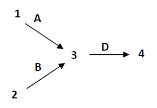Chapter 8 Study Questions
- In the table below, match the mouse hair color phenotypes with the term from the list that best explains the observed phenotype, given the genotypes shown. In this case, the allele symbols do not imply anything about the dominance relationships between the alleles. List of terms: haplosufficiency, haploinsufficiency, pleiotropy, incomplete dominance, co-dominance, incomplete penetrance, broad (variable) expressivity.
A1A1 A1A2 A2A2 1 all hairs black on the same individual: 50% of hairs are all black and 50% of hairs are all white
all hairs white 2 all hairs black all hairs are the same shade of grey all hairs white 3 all hairs black all hairs black 50% of individuals have all white hairs and 50% of individuals have all black hairs 4 all hairs black all hairs black mice have no hair 5 all hairs black all hairs white all hairs white 6 all hairs black all hairs black all hairs white 7 all hairs black all hairs black hairs are a wide range of shades of grey Answer questions 2–4 using the following biochemical pathway for fruit color. Assume all mutations (lower case allele symbols) are recessive, and that either precursor 1 or precursor 2 can be used to produce precursor 3. If the alleles for a particular gene are not listed in a genotype, assume that they are wild-type.

- If 1 and 2 and 3 are all colorless, and 4 is red, what will be the phenotypes associated with the following genotypes?
- aa
- bb
- dd
- aabb
- aadd
- bbdd
- aabbdd
- What will be the phenotypic ratios among the offspring of a cross AaBb × AaBb?
- What will be the phenotypic ratios among the offspring of a cross BbDd × BbDd?
- What will be the phenotypic ratios among the offspring of a cross AaDd × AaDd?
- If 1 and 2 are both colorless, and 3 is blue and 4 is red, what will be the phenotypes associated with the following genotypes?
- aa
- bb
- dd
- aabb
- aadd
- bbdd
- aabbdd
- What will be the phenotypic ratios among the offspring of a cross AaBb × AaBb?
- What will be the phenotypic ratios among the offspring of a cross BbDd × BbDd?
- What will be the phenotypic ratios among the offspring of a cross AaDd × AaDd?
- If 1 is colorless, 2 is yellow and 3 is blue and 4 is red, what will be the phenotypes associated with the following genotypes?
- aa
- bb
- dd
- aabb
- aadd
- bbdd
- aabbdd
- What will be the phenotypic ratios among the offspring of a cross AaBb × AaBb?
- What will be the phenotypic ratios among the offspring of a cross BbDd × BbDd?
- What will be the phenotypic ratios among the offspring of a cross AaDd × AaDd?
- Which of the situations in questions 2 – 4 demonstrate epistasis?
- If the genotypes written within the Punnett Square are from the F2 generation, what would be the phenotypes and genotypes of the F1 and P generations for:
- Figure 8.3.2
- Figure 8.3.4
- Figure 8.3.6
- Figure 8.3.8
- To better understand how genes can control the development of three‐dimensional structures, you conducted a mutant screen in Arabidopsis plant and identified a recessive point mutation allele of a single gene (g) that causes leaves to develop as narrow tubes rather than the broad flat surfaces that develop in wild-type (G). Allele g causes a complete loss of function. Now you want to identify more genes involved in the same process. Diagram a process you could use to identify other genes that interact with gene g. Show all the possible genotypes that could arise in the F1 generation.
- With reference to question 7, if the recessive allele, g is mutated again to make allele g*, what are the possible phenotypes of a homozygous g* g* individual?
- Again, in reference to question 8, what are the possible phenotypes of a homozygous aagg individual, where a is a recessive allele of a second gene? In each case, also specify the phenotypic ratios that would be observed among the F1 progeny of a cross of AaGg × AaGg.
- Use the product rule to calculate the phenotypic ratios expected from a trihybrid cross. Assume independent assortment and no epistasis/gene interactions.

